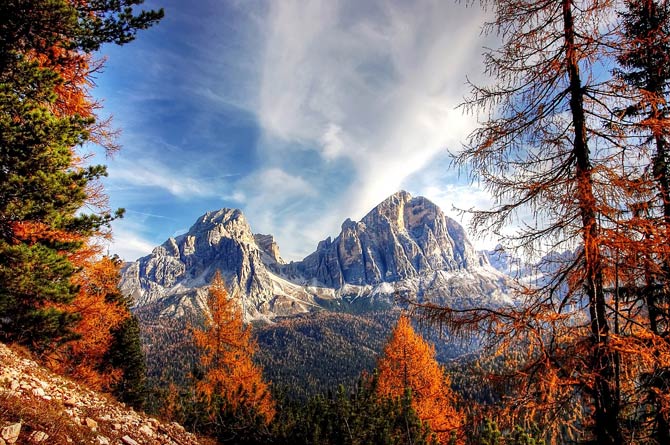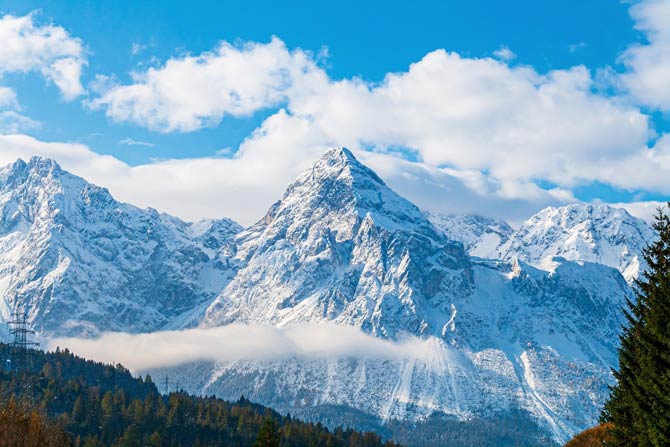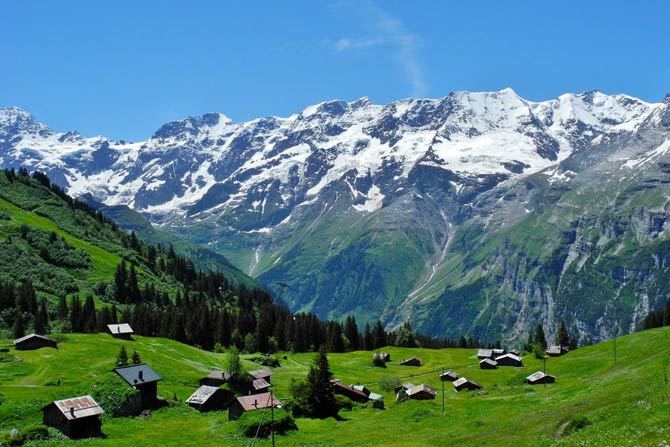Alps – the highest mountains in Europe
There is probably no one who would not associate the Alps with the highest mountain range in Europe. Shrouded in legend Mount Blanc, their highest peak (4,808 m / 15,774 ft), has become the hero of many novels, dramas, poems and paintings over the centuries. Mountains attract tourists like a magnet. The most popular are the Dolomites, but this is only one of the “parts” of these beautiful mountains that trekking enthusiasts travel through in summer and ski in winter.
In the Alps, each tourist and seeker of wildlife will find something for themselves. Due to its length (over 1,200 kilometers / 750 mi), this highest mountain range of the European continent can offer a diverse geological structure, vegetation and climate.

Two climatic zones
The Alps are located in two climatic zones: on the border of temperate and subtropical climates. Within them, the differences in temperature and precipitation are really big. It is from the name of the Alps that any country whose area is largely covered by these mountains is called an Alpine country.
In the case of a mountain range, which covers an area of more than 200,000 square kilometers (77,000 sq mi), it is not one or two countries, but a whole group of them. The Alps are a real geological and natural power.

From the sea to Vienna
The Alps stretch in an arc across nearly half of southern Europe. They are easy to spot on maps and satellite images. They are bounded on one side by the western Mediterranean (or more precisely, by the Gulf of Genoa), on the other by the Little Hungarian Plain and the city of Vienna.
Although they are not as wide as the Australian Great Dividing Range Mountains are still impressive: at their widest points they reach up to 250 kilometers (160 mi). Interestingly, the main ridge of the Alps runs very close to the Apennine ridge, so a point on the map was needed to separate them. Such a point became the Bocchetta di Altare pass, located at an altitude of less than 500 meters (1640 ft) above sea level, in Liguria.
Although the Alps are still rising (but also shrinking due to erosion), their highest peak remains unchanged and that is Mont Blanc, which is 4808 m (15,774 ft) above sea level and lies on the French-Italian border. The Alps are standardly divided into eastern and western, but in fact, within them we will meet many peaks of the different geological structure, with characteristic erosion forms and remnants of glaciers.
The Alps are also many countries, within the boundaries of which they are located, so we can admire them among others in Switzerland, Austria, Germany, France or Italy.

Geological structure and relief
The Alps were uplifted during the Alpine orogeny and are part of the very extensive Alpine-Himalayan range running through three continents (Europe, Africa and Asia). Like most uplifts, this one was also linked to lithosphere plate tectonics, that is, the pushing of one plate against another, in this case, the African and European plates (in the case of the Alps) and additionally the African, Aegean and Indo-Australian plates (in the case of the formation of the entire Alpine-Himalayan range). This was over 55 million years ago, in the Tertiary.
Structure
As a result, the Alps have a fold-and-flat structure. Fold structure is a continuous deformation caused by the bending of rock layers. A plateau, on the other hand, is the overlapping of folded, already accumulated and deposited rock layers on the surface.
The post-glacial heritage can be seen in the valleys with gently rounded slopes (they are called U-shaped valleys as opposed to V-shaped valleys formed by rivers that sharply cut the slopes) and the post-glacial basins that are picturesquely surrounded by soaring peaks. On the north and south sides, the slopes of the Alps are adjoined by the foreland hollows, which include sandstones and loams.

Uplift
The Alps rose in several stages and completed their birth already in the Quaternary. Strong erosion processes by wind, rivers and glaciers acted on them from the beginning. Depending on the resistance of the rocks to these factors, different zones and rock formations were created. The outermost flysch rocks were the least resistant and therefore in these areas we can find low hills (below 2000 m (6,560 ft) above sea level) with gently and slowly sloping slopes.
Higher up is the limestone zone (up to 3000 m / 9,840ft) with well-defined river valleys, monadnocks, crags and developed karst phenomena that can be formed in the limestone rocks without the slightest difficulty. Here you will find extensive cave systems with rich dripstone. The highest parts of the Alps have a high mountain character and are most resistant to erosion, because they are built of crystalline schist. You can find here formations and deformations that remember the times of the Pleistocene.

Climate
Two climatic zones meet in the Alps: temperate in the north and subtropical in the south (in a large generalization, because this mountain range is not straight, but has the shape of an arc). As in all mountains, there is a rule that the higher the mountain, the cooler it is.
When it is over 20℃ (68℉) in the summer in areas close to the coast, the highest peaks tend to have near-zero or negative temperatures. The winter record here is minus 53℃ (-63.4℉). Large amounts of snow fall in winter. It is thanks to the layers of fluff and glaciers that Mont Blanc gets its name (“white mountain”).
The Alps also limit the circulation of air masses. On the northern side, mainly cool polar sea air collects, while the southern slopes reach warm air masses from the Mediterranean Sea. In the east, dry, in winter very cool air from continental regions.

Precipitation
More rainfall occurs in the Western Alps, It can fall as much as 3,000 milliliters (118 in) per year. The Eastern Alps, on the other hand, are drier, not least because of the continental masses of moisture-free air. Here, 2,000 milliliters (79 in) is usually above average.
From a certain altitude (usually above 2,000 meters (6,562 ft) above sea level), only snow falls, adding further layers to the cover in the higher parts of the mountains. Due to the large differences in air temperature and the relief of the terrain, in the Alps there are foehn (föhn) winds that form on the border of the lithosphere and atmosphere. We can also find glaciers here, which – unfortunately – are shrinking as the climate warms up.
Water towers
Each high mountain is an important hydrographic node, sometimes called water towers because they are a reservoir of fresh water gradually released from the snow-ice caps. The Alps are such a junction for all of Europe. High peaks are the source of the main rivers of the continent, such as the Rhine, Rhône and Po.

Rivers
The rivers are fed by both rainwater and snowmelt (therefore, the greatest flows are in summer). This energy is also used in another way: by building hydropower plants.
Lakes
In the Alps, we can also find postglacial souvenirs in the form of lakes (Geneva, Constance (Bodensee) and Garda). Lake Constance (Bodensee) is also a symbolic border between the Eastern and Western Alps, although the ranges themselves have not been symbolically separated – they are characterized by a different geological structure. Crystalline shales, sedimentary rocks (mainly limestones) and even granites meet here.

Fauna and flora of the Alps
As in all high mountains, also in the Alps there is a characteristic staggering of plants. In addition, there is also the influence of the climate. In the south, Mediterranean upland vegetation grows in the lower areas, in the east, we see steppes and forests (mainly oak), in the north deciduous and mixed forests, with a predominance of beech and oak trees.
Up to a height of about 800 meters (2,625ft) above sea level, typical mountain forests grow, with beech, fir, spruce and pine trees, and higher up with larch and Swiss stone pines. Above the forests, there is a layer of subalpine thickets. In the Eastern Alps, we meet mountain pine, in the Western Alps – rhododendron thickets.
The alpine grasslands stretch even higher. Then there are only alps, firn fields and glaciers. In the Alps, many plant species are endemic and under protection. We can find here such popular plants associated with these mountains as crocuses, edelweiss, basalt saxifrage and rosary knotweed.

Animals in the Alps
The world of alpine animals is rich and diverse. Two species of salamanders live here: spotted and black. Birds include the wallcreeper, golden eagle, grouse, alpine accentor, red-billed chough and Alpine Chough (the last two are endemic).
The mammals most associated with the Alps are mainly found in the alpine zone: chamois, ibex (unfortunately close to extinction), white-tailed hare, marmot and European snow vole. In the Alps, we can also meet brown bears. Interestingly, many of the endemic species in these areas are invertebrates, such as some species of snails, butterflies and Arran browns. Cattle and sheep graze in the pastures.
In order to protect the local flora and fauna, national reserves and parks (such as Swiss or the Gran Paradiso) have been created.

Detailed data
The Alps in numbers
- Length of the Alps: 1,200 km (750 mi)
- Width of the Alps: up to 250 km (160 mi)
- Area: 200,000 km2 (77,000 sq mi)
- The highest peak in the Alps: Mont Blanc (4,808 m / 15,774 ft)
- The Alps are located in as many as 8 European countries

Alps – interesting facts
- The Alps are a paradise for tourists and skiers. It has the largest number of ski lifts and cable cars in the world. Huge numbers of people use them every year.
- During the Second Punic War, Hannibal was so ferocious that he decided to cross the Alps with his army and elephants. He managed to achieve it in 10 days, which is an undoubted record. However, a lot of people and many elephants paid for the crazy idea with their lives.
- There are many spectacular waterfalls in the Alps, some of them also impressive in size. Krimml Waterfall is located in Austria and is 380 meters (1,247 feet) high!



















